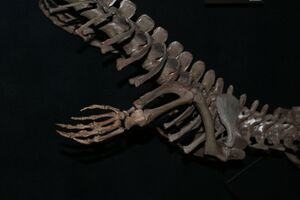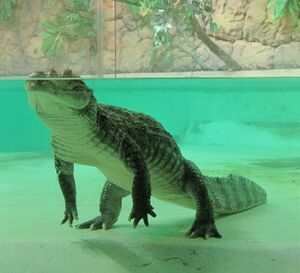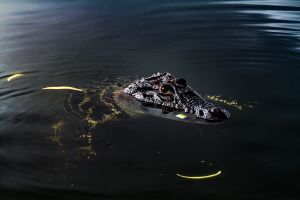القاطورية
| القاطورية | |
|---|---|
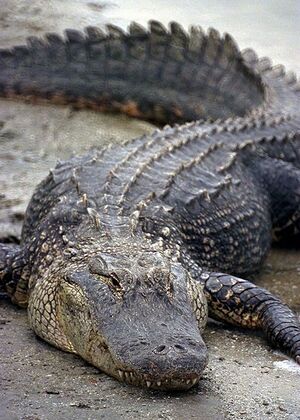
| |
| American alligator (Alligator mississippiensis) | |
| التصنيف العلمي | |
| أصنوفة غير معروفة (أصلحها): | الحياة |
| مملكة: | الحيوانية |
| Phylum: | حبليات |
| Order: | تمساحيات |
| Clade: | الفطساء_المسننة |
| Family: | القاطورية Gray, 1844 |
| Subfamilies | |
The family Alligatoridae of crocodylians includes alligators, caimans and their extinct relatives.
Phylogeny
The superfamily Alligatoroidea includes all crocodilians (fossil and extant) that are more closely related to the American alligator than to either the Nile crocodile or the gharial.[2] This is a stem-based definition for alligators, and is more inclusive than the crown group Alligatoridae.[3] As a crown group, Alligatoridae only includes the last common ancestor of all extant (living) alligators, caimans, and their descendants (living or extinct), whereas Alligatoroidea, as a stem-based group, also includes more basal extinct alligator ancestors that are more closely related to living alligators than to crocodiles or gavialids. When considering only living taxa (neontology), Alligatoroidea and Alligatoridae contain the same species.
The simplified cladogram below shows Alligatoridae's relationships to other extant (living) crocodilians.[3][4][5]
| Crocodylia |
| ||||||||||||||||||||||||||||||||||||||||||||||||||||||||||||||||||||||||
| (crown group) |
Alligatoridae contains eight living species: two alligators within Alligatorinae, and the six caimans of Caimaninae. Phylogenetic studies using molecular DNA consistently resolve their relationships as follows:[6]
| Alligatoridae |
| ||||||||||||||||||||||||||||||||||||||||||
The below detailed cladogram shows one proposal for the internal relationships within Alligatoridae including fossil species, based on morphological analysis[7] (although the exact alligatoroid phylogeny is still disputed).
| Alligatoroidea |
| |||||||||||||||||||||||||||||||||||||||||||||||||||||||||||||||||||||||||||||||||||||||||||||||||||||||||||||||||||||||||||||||||||||||||||||||||||||||||||||||||||||||||||||||||||||||||||||||||||||||||||||||
| (stem-based group) |
Evolution
The superfamily Alligatoroidea is thought to have split from the crocodile-gharial lineage in the late Cretaceous, about 87 million years ago.[8][9] Leidyosuchus of Alberta is the earliest known genus. Fossil alligatoroids have been found throughout Eurasia as land bridges across both the North Atlantic and the Bering Strait have connected North America to Eurasia during the Cretaceous, Paleogene, and Neogene periods. Alligators and caimans split in North America during the early Tertiary or late Cretaceous (about 53 million[9] to about 65 million years ago[8]) and the latter reached South America by the Paleogene, before the closure of the Isthmus of Panama during the Neogene period. The Chinese alligator split from the American alligator about 33 million years ago[9] and likely descended from a lineage that crossed the Bering land bridge during the Neogene. The modern American alligator is well represented in the fossil record of the Pleistocene.[10] The alligator's full mitochondrial genome was sequenced in the 1990s.[11] The full genome, published in 2014, suggests that the alligator evolved much more slowly than mammals and birds.[12]
True alligators
The lineage including alligators proper (Alligatorinae) occurs in the fluvial deposits of the age of the Upper Chalk in Europe, where they did not die out until the Pliocene age. The true alligators are today represented by two species, A. mississippiensis in the southeastern United States, which can grow to 15.6 ft (4.6 m) and weigh 1000 lbs(453 kg),[13] with unverified sizes of up to 19.2 ft(5.9 m). And the small A. sinensis in the Yangtze River, China, which grows to an average of 5 ft (1.5 m). Their name derives from the Spanish el lagarto, which means "the lizard".
Caimans
In Central and South America, the alligator family is represented by six species of the subfamily Caimaninae, which differ from the alligator by the absence of a bony septum between the nostrils, and having ventral armour composed of overlapping bony scutes, each of which is formed of two parts united by a suture. Besides the three species in Caiman, the smooth-fronted caimans in genus Paleosuchus and the black caiman in Melanosuchus are described. Caimans tend to be more agile and crocodile-like in their movements, and have longer, sharper teeth than alligators.[14]
C. crocodilus, the spectacled caiman, has the widest distribution, from southern Mexico to the northern half of Argentina, and grows to a modest size of about 2.2 m (7.2 ft). The largest is the near-threatened Melanosuchus niger, the jacaré-açu or large or black caiman of the Amazon River basin. Black caimans grow to 4.4 m (14.5 ft), with the unverified size of up to 5.7 m (19 ft). The black caiman and American alligator are the only members of the alligator family that pose the same danger to humans as the larger species of the crocodile family.
Although caimans have not been studied in depth, scientists have learned their mating cycles (previously thought to be spontaneous or year-round) are linked to the rainfall cycles and the river levels, which increases chances of survival for their offspring.
Taxonomy
† = extinct
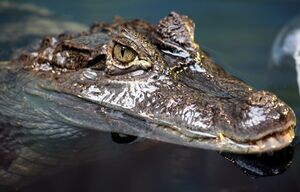
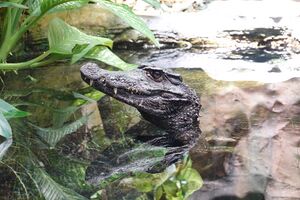
- Family Alligatoridae
- Subfamily Alligatorinae
- Genus Alligator
- † Alligator hailensis
- † Alligator mcgrewi
- † Alligator mefferdi
- Alligator mississippiensis, American alligator
- † Alligator olseni
- † Alligator prenasalis
- Alligator sinensis, Chinese alligator
- † Alligator thomsoni
- Genus † Allognathosuchus
- Genus † Arambourgia
- Genus † Ceratosuchus
- Genus † Chrysochampsa
- Genus † Eoalligator
- Genus † Hassiacosuchus
- Genus † Krabisuchus
- Genus † Navajosuchus?
- Genus † Procaimanoidea
- Genus † Wannaganosuchus
- Genus Alligator
- Subfamily Caimaninae
- Genus † Acresuchus
- Genus † Bottosaurus[15]
- Genus Caiman
- † Caiman brevirostris
- Caiman crocodilus, Spectacled caiman
- Caiman latirostris, Broad-snouted caiman
- † Caiman lutescans
- † Caiman venezuelensis
- † Caiman wannlangstoni
- Caiman yacare, Yacare caiman
- Genus † Centenariosuchus
- Genus † Chinatichampsus
- Genus † Culebrasuchus
- Genus † Eocaiman
- Genus † Globidentosuchus
- Genus † Gnatusuchus
- Genus † Kuttanacaiman
- Genus Melanosuchus
- † Melanosuchus fisheri
- Melanosuchus niger, Black caiman
- Genus † Mourasuchus
- Genus † Necrosuchus
- Genus † Orthogenysuchus
- Genus Paleosuchus
- Paleosuchus palpebrosus, Cuvier's dwarf caiman
- Paleosuchus trigonatus, Smooth-fronted caiman
- Genus † Protocaiman
- Genus † Purussaurus
- Genus † Tsoabichi
- Subfamily Alligatorinae
References
- ^ Family Alligatoridae (Alligators and Caiman) Archived 2016-03-04 at the Wayback Machine University of Bristol. Quote:"The Alligatoridae appears in the Upper Cretaceous while the genus Alligator first occurs in the Oligocene."
- ^ Brochu, Christopher A. (2003). "Phylogenetic approaches toward crocodylian history". Annual Review of Earth and Planetary Sciences. 31: 357–97. doi:10.1146/annurev.earth.31.100901.141308.
- ^ أ ب Michael S. Y. Lee; Adam M. Yates (27 June 2018). "Tip-dating and homoplasy: reconciling the shallow molecular divergences of modern gharials with their long fossil". Proceedings of the Royal Society B: Biological Sciences. 285 (1881). doi:10.1098/rspb.2018.1071. PMC 6030529. PMID 30051855.
- ^ Rio, Jonathan P.; Mannion, Philip D. (6 September 2021). "Phylogenetic analysis of a new morphological dataset elucidates the evolutionary history of Crocodylia and resolves the long-standing gharial problem". PeerJ. 9: e12094. doi:10.7717/peerj.12094. PMC 8428266. PMID 34567843.
- ^ Hekkala, E.; Gatesy, J.; Narechania, A.; Meredith, R.; Russello, M.; Aardema, M. L.; Jensen, E.; Montanari, S.; Brochu, C.; Norell, M.; Amato, G. (2021-04-27). "Paleogenomics illuminates the evolutionary history of the extinct Holocene "horned" crocodile of Madagascar, Voay robustus". Communications Biology (in الإنجليزية). 4 (1): 505. doi:10.1038/s42003-021-02017-0. ISSN 2399-3642. PMC 8079395. PMID 33907305.
- ^ Bittencourt, Pedro Senna; Campos, Zilca; Muniz, Fabio de Lima; Marioni, Boris; Souza, Bruno Campos; Da Silveira, Ronis; de Thoisy, Benoit; Hrbek, Tomas; Farias, Izeni Pires (22 March 2019). "Evidence of cryptic lineages within a small South American crocodilian: the Schneider's dwarf caiman Paleosuchus trigonatus (Alligatoridae: Caimaninae)". PeerJ. 7: e6580. doi:10.7717/peerj.6580. PMC 6433001. PMID 30931177.
- ^ Paula Bona; Martín D. Ezcurra; Francisco Barrios; María V. Fernandez Blanco (2018). "A new Palaeocene crocodylian from southern Argentina sheds light on the early history of caimanines". Proceedings of the Royal Society B: Biological Sciences. 285 (1885): 20180843. doi:10.1098/rspb.2018.0843. PMC 6125902. PMID 30135152.
- ^ أ ب Oaks, J.R. (2011). "A time-calibrated species tree of Crocodylia reveals a recent radiation of the true crocodiles". Evolution. 65 (11): 3285–3297. doi:10.1111/j.1558-5646.2011.01373.x. PMID 22023592. S2CID 7254442.
- ^ أ ب ت Pan, T.; Miao, J.-S.; Zhang, H.-B.; Yan, P.; Lee, P.-S.; Jiang, X.-Y.; Ouyang, J.-H.; Deng, Y.-P.; Zhang, B.-W.; Wu, X.-B. (2020). "Near-complete phylogeny of extant Crocodylia (Reptilia) using mitogenome-based data". Zoological Journal of the Linnean Society. 191 (4): 1075–1089. doi:10.1093/zoolinnean/zlaa074.
- ^ Brochu, Christopher A. (1999). "Phylogenetics, Taxonomy, and Historical Biogeography of Alligatoroidea". Society of Vertebrate Paleontology Memoir. 6: 9–100. doi:10.2307/3889340. JSTOR 3889340.
- ^ Janke, A.; Arnason, U. (1997). "The complete mitochondrial genome of Alligator mississippiensis and the separation between recent archosauria (birds and crocodiles)". Molecular Biology and Evolution. 14 (12): 1266–72. doi:10.1093/oxfordjournals.molbev.a025736. PMID 9402737.
- ^ Green RE, Braun EL, Armstrong J, Earl D, Nguyen N, Hickey G, Vandewege MW, St John JA, Capella-Gutiérrez S, Castoe TA, Kern C, Fujita MK, Opazo JC, Jurka J, Kojima KK, Caballero J, Hubley RM, Smit AF, Platt RN, Lavoie CA, Ramakodi MP, Finger JW, Suh A, Isberg SR, Miles L, Chong AY, Jaratlerdsiri W, Gongora J, Moran C, Iriarte A, McCormack J, Burgess SC, Edwards SV, Lyons E, Williams C, Breen M, Howard JT, Gresham CR, Peterson DG, Schmitz J, Pollock DD, Haussler D, Triplett EW, Zhang G, Irie N, Jarvis ED, Brochu CA, Schmidt CJ, McCarthy FM, Faircloth BC, Hoffmann FG, Glenn TC, Gabaldón T, Paten B, Ray DA (2014). "Three crocodilian genomes reveal ancestral patterns of evolution among archosaurs". Science. 346 (6215): 1254449. doi:10.1126/science.1254449. PMC 4386873. PMID 25504731.
- ^ "American alligator". animals.nationalgeographic.com. National Geographic Society.
- ^ Guggisberg, C.A.W. (1972). Crocodiles: Their Natural History, Folklore, and Conservation. David & Charles. p. 195. ISBN 978-0-7153-5272-4.
- ^ Adam P. Cossette (2020). "A new species of Bottosaurus (Alligatoroidea: Caimaninae) from the Black Peaks Formation (Palaeocene) of Texas indicates an early radiation of North American caimanines". Zoological Journal of the Linnean Society. 191: 276–301. doi:10.1093/zoolinnean/zlz178.
External links
- "Crocodilians: Natural History & Conservation" Archived 2011-07-08 at the Wayback Machine crocodilian.com
- "Family Alligatoridae Gray 1844 (alligator)" Archived 2022-06-05 at the Wayback Machine, fossilworks.org.
 Media related to القاطورية at Wikimedia Commons
Media related to القاطورية at Wikimedia Commons Information related to القاطورية from Wikispecies.
Information related to القاطورية from Wikispecies.
